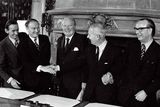Sunningdale and the Ulster Workers’ Strike (Part One): The Power-sharing ‘experiment’
In 1973 the ‘Sunningdale Agreement’ established power-sharing between the UUP and the SDLP


Sunningdale preceded the Good Friday Agreement or Belfast Agreement by 25 years.
It failed, but it did establish power-sharing as the preferred solution to Northern Ireland’s problems.
Sunningdale involved power-sharing between the UUP and the SDLP less than 2 years after the collapse of the NI Parliament and at the very height of the Troubles – a remarkable achievement.
It even had an All-Ireland dimension – but Sunningdale has been mostly forgotten.
What was it?
How did it come about?
And who were the main players?
In the first part of a three-part series, Ciarán Dunbar explores the Sunningdale Agreement and its workings – and asks if it ever had a chance.
Guests:
Join the Belfast Telegraph WhatsApp channel
Stay up to date with some of Northern Ireland's biggest stories



